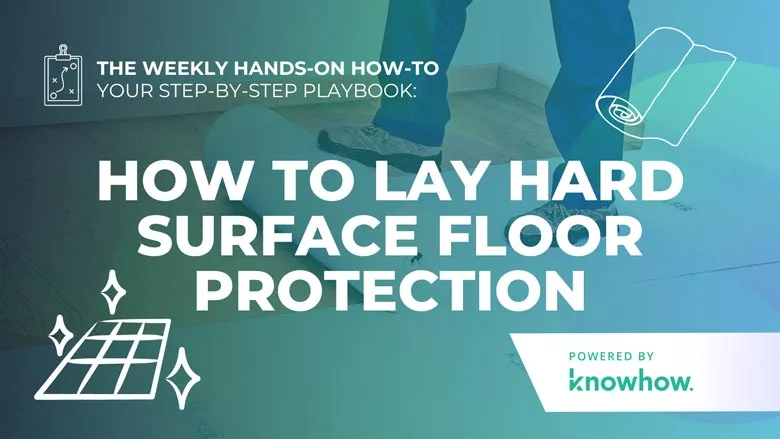Weekly Hands-on How-To powered by KnowHow
How To Lay Hard Surface Floor Protection

Showing consideration for others and their belongings is like investing pennies and getting dollars back. Emotions are high when you enter a client's home after a loss. A great way to defuse this and help your clients feel grounded is to demonstrate your willingness to protect and restore their belongings.
The first thing you should do when you step into a home is ensure its property is protected from further damage during restoration. Laying down floor protection is a simple yet effective way to lead the way with professionalism and care. Beyond just preventing scratches and stains, it's about respecting their space, showing that you’re there to help, and building up your company's image in the community.
In this how-to guide, powered by KnowHow, we'll walk you through the best practices for placing floor protection. Whether covering an entire room or creating a runner, these steps will help you leave a positive impression and a pristine job site.
So, throw on your shoe covers, and let’s walk through this process!
Note: This Weekly Hands-On How-To was based on this template in KnowHow’s template library.
Step 1: Determine the Area
Begin by walking through the area from the site of the damage to the exit or the endpoint of the floor you intend to protect. Measure and calculate the amount of floor protection needed. Communicate your plan to the homeowner, explaining what you are doing and why it’s essential for protecting their property.
Step 2: Gather the Proper Items and Tools
Before you start laying down floor protection, make sure you have all the necessary materials on hand. Having everything ready ensures a smooth and efficient process. Here’s what you’ll need:
- Floor protection material
- Tape (white masking tape, blue painter’s tape, paper tape)
- Utility knife for cutting floor protection
- Safety signs and cones
Gathering the right tools helps execute the task with ease and ensures that the floor protection is applied effectively, preventing potential damage during your work.
Thoroughly inspect the entire area before laying down floor protection. Look for any preexisting damage, especially in common places like:
- Near entryways and exits
- Along baseboards and moldings
- Around furniture legs and corners
- Underneath rugs or mats
Take clear photos of any damages you find and document them in the job file. This documentation helps prevent any disputes about preexisting conditions later on, providing a clear record of the property’s state before your work begins.
Step 4: Clear the Area
Before you start laying down the floor protection, clear the area of any obstacles. Remove all furniture, rugs, and other items from the space you cover. Ensure the pathway is completely clear to allow for a smooth application of the floor protection. This step will prevent disruptions and ensure the floor covering is applied evenly without any obstructions.
Step 5: Clean the Area
The floor must be clean for the floor protection to adhere correctly. Start by thoroughly sweeping the area to remove any loose dirt and debris. Follow this by damp mopping the floor using a gentle cleaner suitable for the flooring type. Make sure the floor is dry before you begin laying down the protection. Cleaning the area ensures the floor protection sticks well and prevents scratches or damage from dirt and debris trapped underneath.

Step 6: Lay Down Floor Protection
After preparing and cleaning the area, you can start laying down the floor protection. This process varies slightly depending on whether you cover an entire room or create a runner.
Covering a Complete Room:
- Begin by covering the baseboards and moldings with blue painter’s tape. This protects these surfaces from the adhesive on the masking tape.
- Place a small section of the floor protection and secure it with masking tape, positioning the tape half on the blue painter’s tape and half on the floor protection.
- Roll out the next floor protection sheet, overlapping each section by 1-2 inches. Secure these sections with masking tape, pressing down firmly to ensure the tape adheres well.
- Use a utility knife to cut the floor protection to fit the area.
Creating a Runner (Hallway):
- Start from the area where you are working and place a small starter piece of floor protection, securing it with masking tape.
- Roll out the floor protection towards the endpoint, keeping it attached to the roll.
- Secure the beginning edge to the starter piece and continue taping along the length until you reach the end.
- Cut the end piece and secure it with tape.
Step 7: Place Warning Signs and Cones
Once the floor protection is in place, set up safety signs and cones along the protected area or at the entry to a completely covered room. This will alert everyone to the protected surface and help prevent accidental trips or movement of the floor covering.
Protect Your Time with KnowHow
The small details often leave the biggest impressions, and taking these essential steps to safeguard a client’s property prevents damage, builds trust, and shows your commitment to quality work.
However, in restoration, there are an incredible number of small but important steps and details to remember, and when the time comes, it can be easy to forget. That’s why managers spend so much time fielding phone calls and questions from employees on the job site. To save this time and provide their teams with instant access to the answers they need, more and more people are turning to KnowHow.
The KnowHow app provides your crew with instant on-the-job guidance based on your SOPs and best practices. They don’t have to call you for every little question, and you can stay focused on your tasks, knowing your team has the reliable support they need at their fingertips.
Visit tryknowhow.com to learn more about how KnowHow provides instant on-the-job support and explore other powerful tools designed to streamline your training, onboarding, and daily operations.
Looking for a reprint of this article?
From high-res PDFs to custom plaques, order your copy today!







